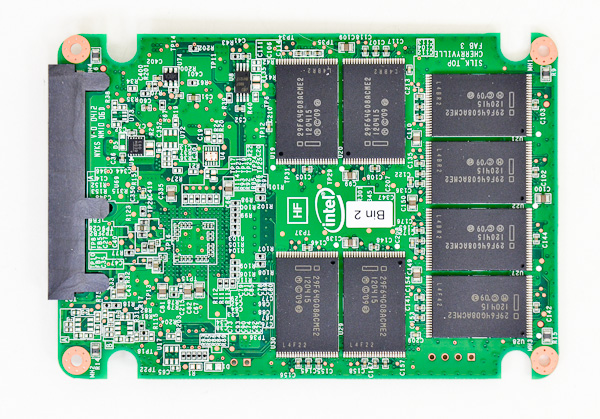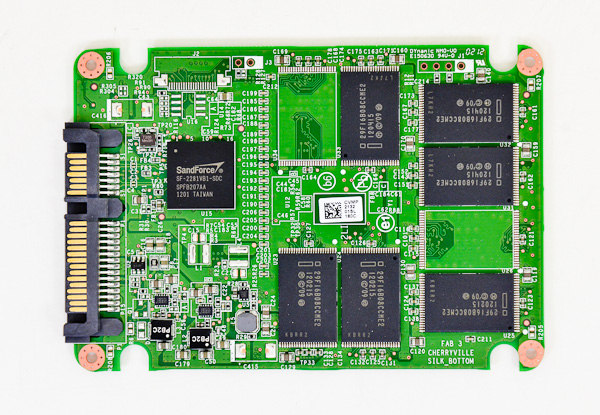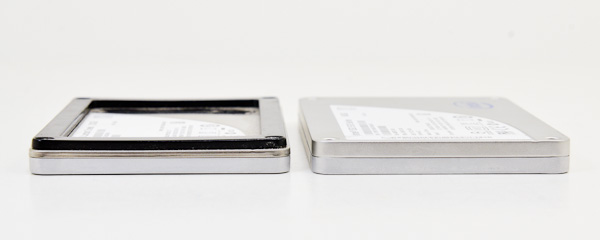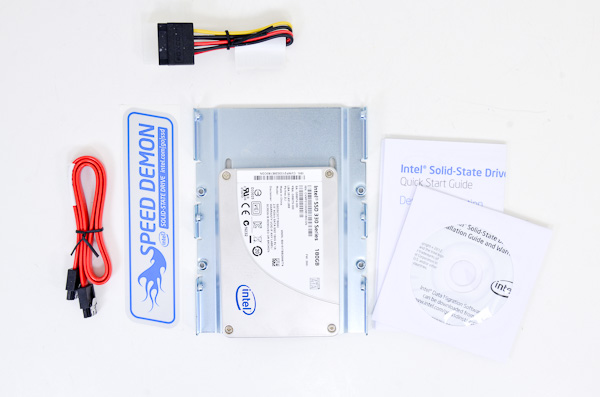The Intel SSD 330 Review (60GB, 120GB, 180GB)
by Anand Lal Shimpi on August 1, 2012 12:01 AM ESTThe Drives and Internal Architecture
The SF-2281 controller features eight NAND channels, although it can pipeline multiple requests on each channel. The 60GB and 120GB drives both feature eight NAND packages with one 8GB die and two 8GB die per package, respectively. That works out to be 64GiB of NAND on the 60GB drive, and 128GiB of NAND on the 120GB drive. RAISE is disabled on both of these drives, all spare area is dedicated for the replacement of bad blocks as well as garbage collection/block recycling.

Intel's SSD 330 60GB, all NAND appears on one side of the PCB
The 180GB drive on the other hand uses twelve NAND packages, with two 8GB 25nm MLC die per package. The math works out to be 192GiB of NAND. SandForce's redundant NAND technology (RAISE) is enabled on the 180GB drive, so the extra spare area is divided between NAND failure coverage as well as traditional garbage collection/bad block replacement. Note the non-multiple-of-eight NAND configuration poses a bit of a challenge for extracting peak performance out of the drive, however it's still able to deliver a tangible advantage over the 120GB version. It's possible that Intel still routes all 8 channels to NAND die and simply sacrifices pipelining of requests on some of the channels.

Intel's 180GB SSD 330 features twelve NAND packages (6 on each side)
In the case of all of the Intel SSD 330 models, the SF-2281 controller is cooled by a thermal pad that helps dissipate heat across the SSD's metal chassis. All 330s are 9.5mm thick without any external removable spacer, which sets these drives apart from most Intel SSDs. Strangely enough, the plastic spacer that's normally on the outside of the drive is actually located on the inside of the 330, although it's not actually responsible for the thicker form factor. I'm not sure why, but it's in there.

Typical 9.5mm Intel SSD (left) vs. 9.5mm Intel SSD 330 (right)
The Bundle
The standard 330 bundle comes with a molex to SATA power adapter, a SATA cable, a 2.5" to 3.5" drive sled and a link to download Intel's Data Migration Software (powered by Acronis).
As the 330 isn't targeted at OEMs, I'm not sure if we'll see standalone drives sold without the bundle. As of now this is the only way to get the 330.












64 Comments
View All Comments
Ryan Smith - Wednesday, August 1, 2012 - link
"I just wish Anand more honest by telling people the truth about SSD, specially SF based controller, because after trying more than 5 SF based SSD, I can say they're sucks! buy it only if you're planning to reformat your drive every now and then"So far every problem we've encountered with SF-2xxx has been documented, e.g. http://www.anandtech.com/show/5508/intel-ssd-520-r...
Beyond that we haven't encountered any additional SF-2xxx issues in our extended deployment testing. For example the 520 (330's sibling) is currently in one of my systems, having replaced a 120GB Vertex 2 that just recently passed 2 years of service.
amikey - Wednesday, August 1, 2012 - link
I have a 180GB SSD 330 in my 2009 Macbook Pro 13". It's totally fine, and running better than ever.Haven't enabled trim or updated the firmware since I got it (no pc to use) either.
I don't use disk encryption though, if you were to do that go with something else.
angelsmaster - Tuesday, September 4, 2012 - link
hi, you didn't update it or whatever? is it still up and running? and i think, its not trim supported when i checked it in the S-ATA system report, btw, i am using a macbook pro 15" 2011... thanks..quanstro - Wednesday, August 1, 2012 - link
how did you get this kind of experience with a just-released drive in a year-old computer?Jumpman23 - Wednesday, August 1, 2012 - link
In terms of cost and reliability the 330 seems like a good deal. What about in terms of performance and reliability? I've been hearing not so good things about the SF drives in general. The M4's and Samsung's 830 seems to get good reviews. So is there any particular drive that stands out as the best of the best?Per Hansson - Wednesday, August 1, 2012 - link
OCZ has a really poor track record when you look at RMA's:http://www.behardware.com/articles/862-7/component...
Weather this is due to the BSOD issue or other issue with their Sandforce drives I don't know.
But if you look at future data even OCZ's Petrol & Octane series has really bad RMA rates:
http://www.behardware.com/articles/862-8/component...
This makes me kind of weary of any Sandforce drive, we can see that since Intel has released Sandforce drives their failure rate has gone from 0.6% > 1.73% in the first link above.
This could be because of the "8MB bug" only but I am not convinced.
I would go for the Crucial M4 drive at this point, it has a great track record and only one known very specific problem (BSOD after 50k hours of ontime, caused by a bug in the SMART values & fixed by a firmware update)
Kristian Vättö - Wednesday, August 1, 2012 - link
The problem with those statistics is that they are extremely limited. Only four manufacturers are listed, and only OCZ's numbers are reported for individual models. The only info on sample size is that there must have been over 500 sales (brand) or 100 sales (model).I'm not defending OCZ or any other brand, just pointing out that a more thorough study would be needed to really know what SSDs are reliable. I do agree that Crucial's m4 is a great buy at the moment, and Samsung 830 and Plextor's SSDs are too.
lyeoh - Wednesday, August 1, 2012 - link
Only OCZ's numbers are reported for individual models becausequoting the article: "only OCZ has models with rates of above 5%".
You may need a more thorough study, but it's good enough for me to avoid OCZ.
Per Hansson - Wednesday, August 1, 2012 - link
Yea, it's a limited sample size but it's all we have to go on.We can also look at Newegg reviews, sure it has it's drawbacks aswell but when you see stuff like this it paints a quite clear picture I think:
128GB OCZ Petrol: http://www.newegg.com/Product/Product.aspx?Item=N8...
128GB OCZ Octane: http://www.newegg.com/Product/Product.aspx?Item=N8...
120GB OCZ RevoDrive 3: http://www.newegg.com/Product/Product.aspx?Item=20...
240GB OCZ Vertex 3: http://www.newegg.com/Product/Product.aspx?Item=N8...
128GB OCZ Vertex 4: http://www.newegg.com/Product/Product.aspx?Item=N8...
128GB Crucial M4: http://www.newegg.com/Product/Product.aspx?Item=N8...
antef - Wednesday, August 1, 2012 - link
I recommend the m4, it's been an amazing drive for me and the reviews on Newegg and Amazon are out of this world, the kind of thing you don't see very often. Don't fret over exact performance and worry that a newer drive might net you something slightly higher, all of these are crazy fast, my Windows machine with the m4 stays on the loading screen for all of 3 seconds, not even enough time to see the four colored orbs form together into the Windows logo.